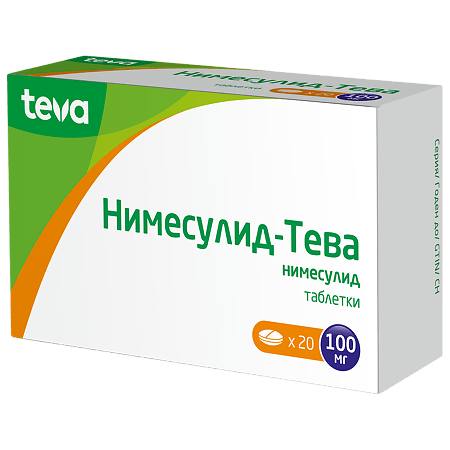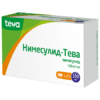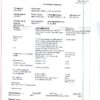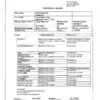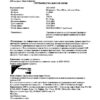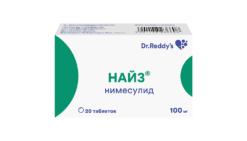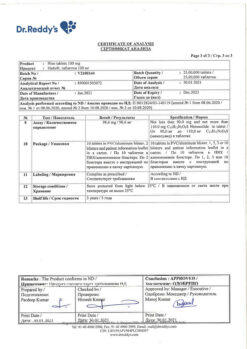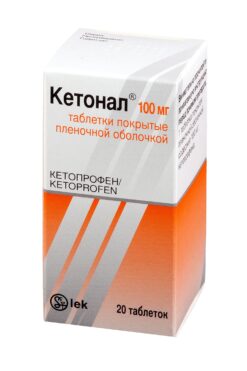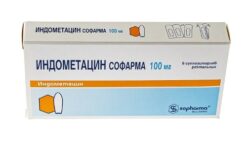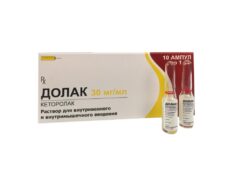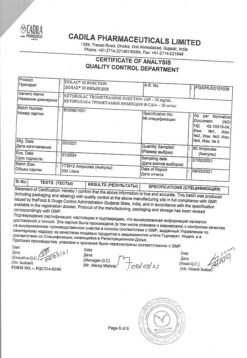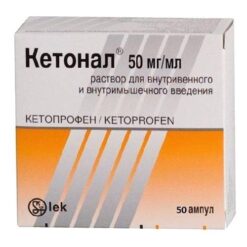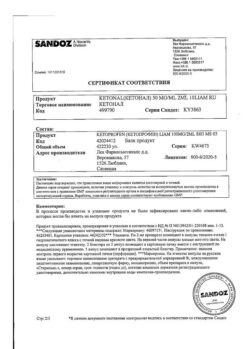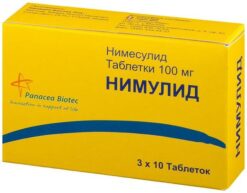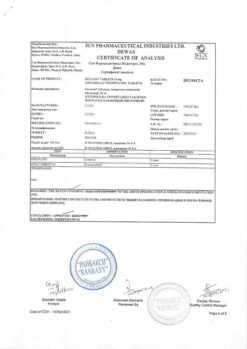No products in the cart.
Nimesulide-Teva, tablets 100 mg 20 pcs
€5.86 €5.21
Description
Pharmacotherapeutic group: Non-steroidal anti-inflammatory drug (NSAID)
ATX code: M01AX17
Pharmacological properties
Pharmacodynamics. Nimesulide belongs to the group of non-steroidal anti-inflammatory drugs (NSAIDs), has anti-inflammatory, analgesic, antipyretic and antiaggregant effects. Unlike indomethacin, it inhibits cyclooxygenase 2 (COX-2) to a greater extent than COX-1 (potentially less often causing side effects associated with inhibition of prostaglandin synthesis in healthy tissues, inhibiting their synthesis mainly in the focus of inflammation).
Pharmacokinetics. Nimesulide is well absorbed when taken orally (eating reduces the rate of absorption without affecting its degree). After a single administration of 100 mg of nimesulide the maximum concentration (Cmax) in blood plasma in adults reaches 3-4 mg/l and is observed after 2-3 hours. Binding with plasma proteins is 95%, with erythrocytes – 2%, with lipoproteins – 1%, with acidic alpha1-glycoproteins – 1%. Increasing the dose does not affect the degree of binding.
The area under the curve “concentration-time” (AUC) is 20-35 mg h/l. No statistically significant differences were found between these parameters after a single dose and administration for 7 days in a dose of 100 mg twice a day.
The volume of distribution is 0.19-0.35 l/kg. It easily penetrates through histohematic barriers (in female genital tissues after a single nimesulide administration its concentration is about 40% of the blood plasma concentration), including acidic environment of the inflammatory focus and synovial fluid (40% and 43% of the blood plasma concentration, respectively).
It is metabolized in liver with participation of monooxygenases, including cytochrome P450 (CYP) 2C9 system. The main metabolite is water-soluble 4-hydroxynimesulide (25%), which has pharmacological activity similar to nimesulide.
Nimesulide is excreted mainly in the urine (approximately 50% of the dose taken). The half-life (T1/2) of nimesulide is 3-6 hours, of 4-hydroxynimesulide – 3-5 hours. 4-hydroxynimesulide is excreted by the kidneys (65%) and with the bile (35%); it undergoes enterohepatic recirculation.
Only 1-3% of nimesulide is excreted unchanged. Approximately 29% of the dose is excreted as a metabolite in the feces.
The pharmacokinetic profile of nimesulide in the elderly does not change after single and repeated administration of the drug.
In patients with mild to moderate renal impairment – creatinine clearance (CK) 30-80 ml/min, Cmax of nimesulide and its main metabolite in plasma are not higher than those of healthy volunteers. Repeated administration of nimesulide is not accompanied by its cumulation.
Indications
Indications
Acute pain therapy:
– pain in the lower back and/or lumbar region;
– pain syndrome associated with diseases of the musculoskeletal system, including tendinitis, bursitis;
– pain from bruises, sprains and dislocations of joints;
– toothache;
– elimination of painful sensations in osteoarthritis (osteoarthritis) with pain syndrome;
– pain during menstruation.
The drug is intended to eliminate the symptoms of the disease, reduce pain and inflammation at the time of use, and does not affect the progression of the disease. Nimesulide is recommended for therapy as a second-line drug (i.e., as a drug when the initial/main therapy for the disease is ineffective or there are contraindications).
If there is no improvement or you feel worse, consult a doctor.
Pharmacological effect
Pharmacological effect
Pharmacotherapeutic group: non-steroidal anti-inflammatory drug (NSAID)
ATX code: M01AX17
Pharmacological properties
Pharmacodynamics. Nimesulide is a non-steroidal anti-inflammatory drug (NSAID) and has anti-inflammatory, analgesic, antipyretic and antiplatelet effects. Unlike indomethacin, it inhibits cyclooxygenase 2 (COX-2) to a greater extent than COX-1 (potentially less likely to cause side effects associated with inhibition of prostaglandin synthesis in healthy tissues, inhibiting their synthesis mainly at the site of inflammation).
Pharmacokinetics. Nimesulide is well absorbed when taken orally (food intake reduces the rate of absorption without affecting its degree). After a single dose of 100 mg of nimesulide, the maximum concentration (Cmax) in blood plasma in adults reaches 3-4 mg/l and is observed after 2-3 hours. Communication with blood plasma proteins – 95%, with erythrocytes – 2%, with lipoproteins – 1%, with acidic alpha1-glycoproteins – 1%. Increasing the dose does not affect the degree of binding.
The area under the concentration-time curve (AUC) is 20-35 mg h/l. No statistically significant differences were found between these parameters after a single dose and administration for 7 days at a dose of 100 mg 2 times a day.
Volume of distribution – 0.19-0.35 l/kg. Easily penetrates histohematic barriers (in the tissues of the female genital organs after a single dose of nimesulide, the concentration is about 40% of the concentration in the blood plasma), incl. into the acidic environment of the inflammation site and synovial fluid (40% and 43%, respectively, of the concentration in the blood plasma).
Metabolized in the liver with the participation of monooxygenases, incl. cytochrome P450 (CYP) 2C9 system. The main metabolite, water-soluble 4-hydroxynimesulide (25%), has pharmacological activity similar to nimesulide.
Nimesulide is excreted mainly in the urine (approximately 50% of the dose taken). The half-life (T1/2) of nimesulide is 3-6 hours, 4-hydroxynimesulide is 3-5 hours. 4-hydroxynimesulide is excreted by the kidneys (65%) and bile (35%), and undergoes enterohepatic recirculation.
Only 1-3% of nimesulide is excreted unchanged. Approximately 29% of the dose is excreted as a metabolite in the feces.
The pharmacokinetic profile of nimesulide in elderly people does not change after a single or repeated dose of the drug.
In patients with mild to moderate renal impairment, creatinine clearance (CC) is 30-80 ml/min, Cmax of nimesulide and its main metabolite in blood plasma does not exceed those in healthy volunteers. Repeated administration of nimesulide is not accompanied by its accumulation.
Special instructions
Special instructions
Driving vehicles and working with machinery
You should refrain from driving vehicles and engaging in other potentially hazardous activities that require increased concentration and speed of psychomotor reactions, as the drug may cause dizziness and other side effects that may affect these abilities.
Nimesulide-Teva contains lactose monohydrate.
If your doctor has told you that you have an intolerance to certain sugars, talk to your doctor before taking this drug.
Active ingredient
Active ingredient
Nimesulide
Composition
Composition
The active substance is nimesulide. Each tablet contains 100 mg of nimesulide.
Other ingredients (excipients) of the drug are: sodium docusate, hyprolose, lactose monohydrate, sodium carboxymethyl starch, microcrystalline cellulose, magnesium stearate, hydrogenated vegetable oil.
Pregnancy
Pregnancy
If you are pregnant or breastfeeding, think you may be pregnant, or are planning a pregnancy, consult your doctor before using this medicine. If you can become pregnant, you must use effective contraception while taking the drug.
PREGNANCY
Taking Nimesulide-Teva during pregnancy is contraindicated.
BREASTFEEDING
Taking Nimesulide-Teva during breastfeeding is contraindicated.
FERTILITY
It is not recommended to take Nimesulide-Teva for women planning pregnancy.
Contraindications
Contraindications
Do not take Nimesulide-Teva if you have:
allergy to nimesulide or any other components of the drug listed in section 6 of the package insert;
complete or incomplete combination of bronchial asthma, recurrent inflammation of the nasal mucosa, paranasal sinuses and intolerance to acetylsalicylic acid and other non-steroidal anti-inflammatory drugs (NSAIDs), incl. in the anamnesis (history of the disease);
history of hepatotoxic reactions (reactions causing structural and functional disorders of the liver) to nimesulide;
simultaneous use with other drugs with potential hepatotoxicity (structural and functional liver disorders) (for example, other NSAIDs);
chronic inflammatory bowel diseases (Crohn’s disease, ulcerative colitis) in the acute phase;
period after coronary artery bypass surgery;
febrile syndrome with colds and acute respiratory viral infections;
suspicion of acute surgical pathology;
peptic ulcer of the stomach or duodenum in the acute phase;
erosive and ulcerative lesions of the gastrointestinal tract (GIT) in the acute phase;
history of erosive and ulcerative lesions of the gastrointestinal tract;
the formation of a through defect in the gastrointestinal tract (perforation) or a history of gastrointestinal bleeding, including those associated with previous NSAID therapy;
a history of hemorrhages from cerebral vessels, other active bleeding or diseases accompanied by increased bleeding;
severe blood clotting disorders;
severe heart failure;
severe renal failure (creatinine clearance less than 30 ml/min);
progressive kidney disease;
a confirmed increase in the level of potassium in the blood plasma (hyperkalemia);
liver failure, active liver disease;
children under 12 years of age;
pregnancy and breastfeeding;
alcoholism;
drug addiction;
congenital lactose intolerance, impaired absorption of glucose-galactose, lactase deficiency.
Special instructions and precautions
Before taking Nimesulide-Teva, consult your doctor.
Undesirable side effects can be minimized by using the drug in the minimum effective dose with the minimum duration of use necessary to relieve pain.
With caution
arterial hypertension;
coronary heart disease;
vascular diseases of the brain;
severe heart failure;
pathological changes in the levels of cholesterol and other lipids (fats) (dyslipidemia);
increased levels of cholesterol and other lipids (fats) in the blood (hyperlipidemia);
diabetes mellitus;
peripheral arterial disease;
state of increased bleeding (hemorrhagic diathesis);
smoking;
renal failure (creatinine clearance 30-60 ml/min);
existing cases of development of erosive and ulcerative lesions of the gastrointestinal tract, the presence of Helicobacter pylori infection;
old age;
long-term use of non-steroidal anti-inflammatory drugs;
frequent alcohol consumption, severe somatic diseases, systemic lupus erythematosus (SLE) and other systemic connective tissue diseases;
concomitant therapy with the following drugs: anticoagulants – drugs that inhibit the blood clotting process (for example, warfarin), antiplatelet agents – drugs that prevent the formation of blood clots (for example, acetylsalicylic acid, clopidogrel), oral glucocorticosteroids – hormones (for example, prednisolone), selective serotonin reuptake inhibitors – antidepressants, drugs for the treatment of anxiety disorders and depression (eg citalopram, fluoxetine, paroxetine, sertraline).
Nimesulide should be used with extreme caution in patients with arterial hypertension, renal and/or heart failure, coronary heart disease, peripheral arterial disease and/or cerebrovascular disease, with risk factors for the development of cardiovascular diseases (for example: hyperlipidemia, diabetes mellitus, smokers) due to the fact that the drug can cause fluid retention in tissues. If the condition worsens, treatment with nimesulide should be discontinued.
If signs of a “cold” or acute respiratory viral infection occur during the use of nimesulide, the drug should be discontinued.
LIVER REACTIONS
There is evidence of very rare cases of serious reactions from the liver, including cases of death, associated with the use of nimesulide-containing drugs. If symptoms similar to signs of liver damage appear (anorexia – lack of appetite in the presence of a physiological need for nutrition, itching, yellowing of the skin, nausea, vomiting, abdominal pain, dark urine, increased activity of liver transaminases), you should immediately stop using nimesulide and consult a doctor. Repeated use of nimesulide after the onset of such symptoms is contraindicated. After 2 weeks of using the drug, monitoring of liver function parameters (“transaminases”) is necessary. Liver reactions, which are in most cases reversible, have been reported with short-term use of the drug.
SAFE USE FOR THE GASTROINTESTINAL TRACT
While using nimesulide, you should refrain from taking other analgesics, including NSAIDs (including selective COX-2 inhibitors: celecoxib, valdecoxib, meloxicam).
GASTROINTESTINAL BLEEDING
Nimesulide should be used with caution if you have chronic gastrointestinal diseases (ulcerative colitis, Crohn’s disease), since exacerbation of these diseases is possible. The risk of gastrointestinal bleeding, peptic ulcer/perforation of the stomach or duodenum increases with a history of gastrointestinal ulceration (ulcerative colitis, Crohn’s disease), as well as if you are an elderly person, with an increase in the dose of NSAIDs, so treatment should be started with the lowest possible dose. To reduce the risk of gastrointestinal bleeding, as well as with the simultaneous use of low doses of acetylsalicylic acid, it may be necessary to take simultaneous medications that have a protective effect on the gastric and intestinal mucosa (for example, misoprostol or proton pump blockers). If you have chronic gastrointestinal diseases, especially if you are elderly, immediately tell your doctor about any gastrointestinal symptoms (especially symptoms that may indicate possible gastrointestinal bleeding).
Nimesulide should be taken with caution if you are taking drugs that increase the risk of ulceration or bleeding (oral corticosteroids, anticoagulants, for example, warfarin, selective serotonin reuptake inhibitors or antiplatelet agents – suppress the excessive functional activity of platelets involved in blood clotting, for example, acetylsalicylic acid). If gastrointestinal bleeding or ulcerative lesions of the gastrointestinal tract occur, treatment with the drug must be stopped immediately.
IMPACT ON VISUAL FUNCTION
If any visual disturbance occurs, the use of nimesulide should be stopped immediately and an eye examination should be performed.
IMPACT ON THE CARDIOVASCULAR SYSTEM
There may be an increased risk of heart attack or cerebrovascular accident (stroke) when taking medications such as Nimesulide-Teva. To reduce the risk of side effects, do not exceed the recommended dose and duration of treatment.
Nimesulide can change the properties of platelets (blood cells that help form clots and stop bleeding), so care must be taken when using the drug in people with hemorrhagic diathesis (a state of increased bleeding), however, the drug does not replace the preventive effect of acetylsalicylic acid in cardiovascular diseases.
SKIN REACTIONS
Severe skin reactions may occur when taking NSAIDs, including nimesulide, including severe skin inflammation with redness and peeling (exfoliative dermatitis), large blisters over large areas of skin and mucous membranes (Stevens-Johnson syndrome), and blistering and peeling of large areas of skin (toxic epidermal necrolysis).
At the first manifestations of a skin rash, damage to the mucous membranes or other signs of an allergic reaction, nimesulide should be stopped immediately.
Elderly patients
Elderly patients are particularly susceptible to adverse reactions to NSAIDs, including the risk of life-threatening gastrointestinal bleeding and perforation, and decreased renal, liver, and cardiac function. If you belong to this category of patients, then you need proper clinical supervision when taking nimesulide.
Children
Nimesulide-Teva is contraindicated for children under 12 years of age.
Side Effects
Side Effects
Like all medicines, Nimesulide-Teva can cause side effects, although not everyone gets them.
Stop taking Nimesulide-Teva and tell your doctor immediately if you experience any of the following adverse reactions:
skin rash, swelling of the face, lips, tongue or throat, hives, difficulty breathing or swallowing (early signs of an anaphylactic reaction);
anorexia (see section 2: “Special instructions and precautions”);
itching, yellowing of the skin (see section 2: “Special instructions and precautions”);
nausea, vomiting, abdominal pain (see section 2: “Special instructions and precautions”);
darkening of urine (see section 2: “Special instructions and precautions”);
increased activity of “liver” transaminases (see section 2: “Special instructions and precautions”);
gastrointestinal bleeding or ulcerative lesions of the gastrointestinal tract (see section 2: “Special instructions and precautions”);
visual impairment (see section 2: “Special instructions and precautions”);
signs of a “cold” or acute respiratory viral infection (see section 2: “Special instructions and precautions”).
Long-term use of any NSAIDs (especially in high doses) may be accompanied by an increased risk of blood clots in the arteries (including those manifested by myocardial infarction (acute disease affecting the heart muscle) or ischemic stroke (acute circulatory disorder in the brain or spinal cord) (see section 2: “Special instructions and precautions”).
With the use of NSAIDs, it is possible to develop edema syndrome, arterial hypertension, and worsen the course of heart failure. Serious skin reactions, including Stevens-Johnson syndrome and toxic epidermal necrolysis (Lyell’s syndrome), have been reported very rarely (see Section 2: Warnings and Precautions).
Most often, various gastrointestinal disorders are observed (especially in predisposed and elderly people): peptic ulcers, perforation of the gastrointestinal wall, the development of potentially severe gastrointestinal bleeding, nausea, vomiting, hematemesis, flatulence, abdominal pain, diarrhea, constipation, melena (discharge of dark sticky feces, a sign of gastrointestinal bleeding), stomatitis (inflammation of the mucous membrane oral cavity), ulcerative colitis (chronic inflammation of the mucous membrane of the colon with the development of ulcers), manifestations of gastritis (inflammation of the gastric mucosa) are less common (see section 2: “Special instructions and precautions”).
There are also other undesirable reactions:
Common reactions (may affect up to 1 in 10 people):
diarrhea (frequent bowel movements, in which the stool has a liquid consistency);
nausea;
vomit;
increased activity of “liver” enzymes in the blood.
Uncommon reactions (may affect up to 1 in 100 people):
dizziness;
increased blood pressure;
dyspnea;
constipation;
flatulence (bloating due to the accumulation of gases in the intestines);
gastritis (inflammation of the gastric mucosa);
gastrointestinal bleeding;
ulcer and/or perforation (the occurrence of a through defect in the wall of a hollow organ) of the stomach or duodenum;
itching;
skin rash;
increased sweating;
peripheral edema (localized in the lowest part of the body)
Rare reactions (may affect up to 1 in 1000 people):
anemia (decreased hemoglobin content in the blood);
eosinophilia (increased levels of white blood cells);
hemorrhages (bleedings);
hypersensitivity reactions;
feeling of fear;
nervousness;
nightly “nightmare” dreams;
blurred vision;
tachycardia (increased heart rate);
feeling of heartbeat;
instability of blood pressure;
“flushes” of blood to the skin of the face;
erythema (redness of the skin);
dermatitis (skin inflammation);
dysuria (impaired urination);
hematuria (presence of blood in the urine);
urinary retention;
malaise;
asthenia (increased fatigue with mood swings, weakness, irritability, sleep disorders).
Very rare reactions (may affect up to 1 in 10,000 people):
thrombocytopenia (a decrease in platelets in the blood, accompanied by increased bleeding and problems stopping bleeding);
pancytopenia (deficiency of blood cells – red blood cells, white blood cells and platelets);
thrombocytopenic purpura (periodic or constant decrease in platelets in the blood and increased risk of bleeding);
increased duration of bleeding;
anaphylactoid reactions (severe allergic reactions);
headache;
drowsiness;
encephalopathy (Reye’s syndrome) – hepatic encephalopathy (impaired brain function in patients with liver failure) and fatty liver degeneration;
visual impairment;
vertigo (dizziness);
exacerbation of bronchial asthma;
bronchospasm (wheezing, difficulty exhaling, shortness of breath, increasing respiratory failure);
stomach ache;
dyspepsia (digestive disorder);
stomatitis (inflammation of the oral mucosa);
tarry stools;
hepatitis (liver inflammation);
fulminant (fulminant) hepatitis (including deaths);
jaundice (staining of the skin and mucous membranes yellow);
cholestasis (stagnation of bile in the bile ducts);
urticaria (sudden widespread rash of itchy blisters of an allergic nature);
angioedema (acutely developing and rapidly passing swelling of the skin and subcutaneous tissue or mucous membranes);
swelling of the face;
erythema multiforme (acute skin disease with the appearance of symmetrical fixed red nodules);
Stevens-Johnson syndrome (the appearance of blisters on large areas of the skin and mucous membranes);
toxic epidermal necrolysis (Lyell’s syndrome), which is the formation of blisters and peeling of the skin over large areas of the skin;
renal failure (impaired kidney function);
oliguria (reduced urine output);
interstitial nephritis (inflammatory kidney damage);
hyperkalemia (increased potassium in blood plasma);
hypothermia (lowering body temperature below 36 degrees).
Interaction
Interaction
Tell your doctor if you are taking, have recently taken, or may start taking any other medications.
This may be especially important if you are taking any of the following medications:
– Glucocorticosteroids;
– Selective serotonin reuptake inhibitors (SSRIs) (eg, fluoxetine);
– Antiplatelet drugs – suppress the functional activity of platelets, for example, acetylsalicylic acid, and anticoagulants – drugs that inhibit the blood clotting process, for example, warfarin;
– Other NSAIDs (painkillers);
– Diuretics, for example furosemide (diuretics);
– Angiotensin-converting enzyme (ACE) inhibitors and angiotensin-II receptor antagonists (drugs for the treatment of heart failure);
– Mifepristone (abortion drug);
– Lithium preparations (for the treatment of mental illness);
– Medicines that are substrates of the CYP2C9 enzyme;
– Methotrexate (a medicine used to treat certain inflammatory diseases and cancer);
– Cyclosporines (drugs used to suppress the immune system after organ transplantation to prevent organ rejection);
– Tolbutamide (a drug for the treatment of diabetes mellitus);
– Salicylic (antiseptic) and valproic acid (anti-epileptic, for the treatment of bipolar disorder and migraines).
Storage conditions
Storage conditions
Store at a temperature not exceeding 25 °C.
Keep out of the reach of children!
Do not use the drug after the expiration date indicated on the blister or carton after “Best before:”. The expiration date is the last day of the specified month.
Manufacturer
Manufacturer
Blupharma Industry Pharmaceuticals S.A., Portugal
Additional information
| Shelf life | 3 years. Do not use after the expiration date stated on the package. |
|---|---|
| Conditions of storage | Store at a temperature not exceeding 25 ° C. Keep out of reach of children! |
| Manufacturer | Blufarma Industria Pharmaceutica S.A., Portugal |
| Medication form | pills |
| Brand | Blufarma Industria Pharmaceutica S.A. |
Related products
Buy Nimesulide-Teva, tablets 100 mg 20 pcs with delivery to USA, UK, Europe and over 120 other countries.

